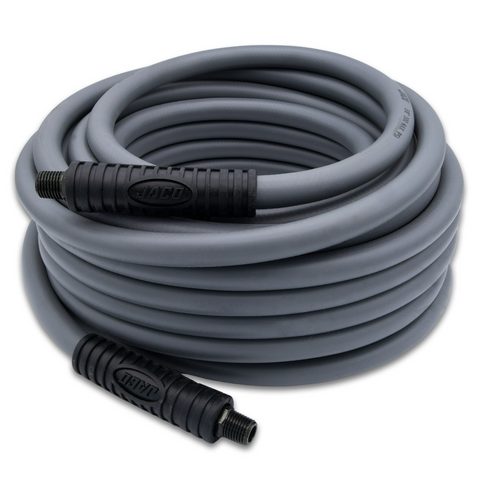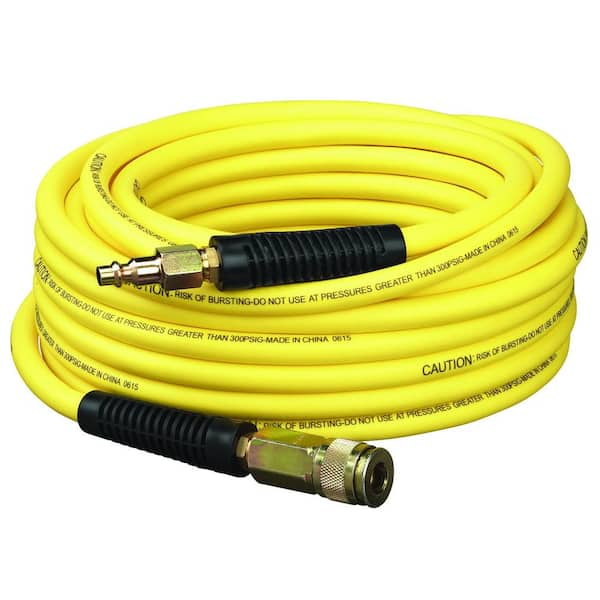Looking for an air compressor hose that gives you the freedom to move around without constantly worrying about reaching your tools? A 50 ft air compressor hose might be exactly what you need.
Imagine the ease of working on your projects with a hose long enough to cover large areas, yet durable enough to handle tough jobs. You’ll discover why choosing the right 50 ft air compressor hose can save you time, reduce frustration, and make your work smoother than ever before.
Keep reading to find out how to pick the perfect hose that fits your needs and boosts your productivity.

Credit: www.amazon.com
Choosing The Right 50 Ft Air Compressor Hose
Choosing the right 50 ft air compressor hose is important for your work. A good hose makes your tasks easier and safer. This guide helps you pick the best hose for your needs. Focus on material, size, and pressure ratings. These factors affect performance and durability.
Material Types And Their Benefits
Air compressor hoses come in several materials. Rubber hoses are flexible and resist wear. They work well in cold weather. PVC hoses are lightweight and easy to handle. They resist kinks but are less flexible. Hybrid hoses combine rubber and PVC. They offer good flexibility and durability. Choose material based on your work environment and hose use.
Diameter And Length Considerations
The diameter affects airflow and tool performance. Common sizes are 1/4 inch and 3/8 inch. Larger diameters allow more air but are heavier. Length matters too. A 50 ft hose gives good reach without too much pressure loss. Too long or too short hoses can cause problems. Pick a diameter and length that fits your tools and workspace.
Pressure Ratings And Compatibility
Check the hose pressure rating. It must match or exceed your air compressor’s output. Most 50 ft hoses handle 150 to 300 PSI. Higher pressure hoses are stronger but heavier. Also, check the fittings and connectors. They should fit your compressor and tools tightly. Proper compatibility prevents leaks and keeps air flow steady.
Installation Tips For Optimal Use
Installing a 50 ft air compressor hose correctly helps it last longer and work better. Proper setup reduces leaks and air loss. Follow simple steps to keep your hose safe and efficient.
Proper Hose Connections
Check the hose ends for dirt or damage before connecting. Use the right fittings that match your compressor and tools. Tighten connections firmly but avoid over-tightening to prevent damage. Leak-free connections save air and energy.
Avoiding Kinks And Twists
Lay the hose straight and avoid sharp bends. Twists and kinks block air flow and cause wear. Move the hose gently when using it. Let the hose unwind naturally from the reel or coil. Smooth airflow means better tool performance.
Storage Best Practices
Store the hose in a cool, dry place away from direct sunlight. Coil the hose loosely to prevent stress points. Avoid heavy objects on top of the hose. Proper storage stops cracks and extends the hose life.
Maintenance For Longevity
Proper maintenance extends the life of your air compressor hose 50 ft. Regular care keeps it safe and efficient. A well-maintained hose prevents leaks and pressure loss. It also saves money by avoiding early replacements. Follow simple steps to keep your hose working well for years.
Regular Cleaning Methods
Clean the hose after each use to remove dirt and debris. Use a soft cloth and mild soap with water. Avoid harsh chemicals that can damage the hose material. Let the hose dry completely before storing it. Keeping the hose clean prevents clogs and wear.
Inspecting For Wear And Damage
Check the hose regularly for cracks, cuts, or bulges. Look closely at the fittings and connections. Any damage can cause leaks or bursts. Test the hose by running air through it at low pressure. Replace the hose if you see any signs of damage.
When To Replace Your Hose
Replace your air compressor hose if it leaks or bursts. Also, change it if the hose feels stiff or brittle. Old hoses lose flexibility and safety. A damaged hose can cause accidents or tool failure. Timely replacement ensures safe and smooth operation.

Credit: jacosuperiorproducts.com
Troubleshooting Common Issues
Troubleshooting common issues with your Air Compressor Hose 50 Ft helps keep your tools running smoothly. Small problems can cause big delays and reduce the hose’s life. Identifying and fixing these issues quickly saves time and money.
Leaks And Air Pressure Loss
Leaks cause a drop in air pressure and reduce tool power. Check the hose for cracks, holes, or worn spots. Use soapy water on the hose surface; bubbles show leaks. Tighten connections and replace damaged parts to fix leaks. Keep the hose clean and store it properly to avoid damage.
Hose Blockages
Blockages stop air from flowing freely through the hose. Dirt, debris, or kinks can block the path inside. Straighten any bends and shake the hose to remove loose dirt. Flush the hose with compressed air from the opposite end. Regular cleaning prevents blockages and keeps the hose clear.
Fitting And Coupler Problems
Loose or damaged fittings cause poor air flow and leaks. Check couplers and fittings for tightness and wear. Replace worn seals or broken parts. Use the correct size fittings for your hose. Proper connections maintain air pressure and prevent disconnections during use.
Enhancing Performance With Accessories
Choosing the right air compressor hose is important. Adding the right accessories can make a big difference. Accessories improve ease of use and extend hose life. They also help maintain steady air flow and boost overall tool performance.
Accessories like hose reels and quick connectors save time and effort. Safety equipment keeps the work environment secure. Each accessory plays a key role in making your air compressor setup better.
Using Hose Reels
Hose reels keep your 50 ft air compressor hose neat. They stop the hose from tangling or getting damaged. Hose reels make storing and moving the hose easier. Using a reel can increase the hose’s lifespan. It also helps prevent tripping hazards in the workspace.
Quick Connectors And Adapters
Quick connectors allow fast and secure hose connections. They reduce time spent attaching and detaching tools. Adapters help connect hoses to different tools easily. These accessories make switching between tasks smooth. They maintain strong seals to avoid air leaks.
Safety Equipment Recommendations
Using safety gear protects you from air pressure risks. Wear safety glasses to guard your eyes from debris. Gloves prevent hand injuries from hose handling. Check hoses regularly for cracks or leaks. A pressure regulator helps control air flow safely.

Credit: www.homedepot.com
Comparing Popular Brands And Models
Choosing the right air compressor hose 50 ft can be confusing. Many brands offer different features and prices. Comparing popular models helps find the best fit for your needs.
This section breaks down options by budget, performance, and user feedback. It makes your choice easier and smarter.
Budget-friendly Options
Some brands focus on affordability without losing quality. These hoses work well for light tasks and occasional use. They often use durable materials but may lack extra features.
Examples include basic PVC or rubber hoses. These are flexible and easy to handle. They fit smaller compressors and home projects well.
High-performance Choices
High-performance hoses suit heavy-duty and professional work. They often have reinforced layers to resist kinks and abrasion. These hoses deliver higher air pressure with less loss.
Look for models with premium rubber or hybrid materials. They last longer and handle tough conditions better. Some brands offer longer warranties for extra confidence.
Customer Reviews And Ratings
User feedback reveals real-life performance and durability. Check ratings to see if hoses meet expectations over time. Pay attention to common issues like leaks or stiffness.
Customers often share tips on maintenance and compatibility. Reviews help spot brands that provide good value and support. Choose hoses with mostly positive experiences reported.
Frequently Asked Questions
What Is An Air Compressor Hose 50 Ft Used For?
An air compressor hose 50 ft connects air tools to the compressor. It provides flexibility and reach for various tasks. This length suits outdoor or large workspace needs. It ensures efficient air flow and tool performance. Ideal for automotive, construction, and home projects.
How To Choose The Best 50 Ft Air Compressor Hose?
Consider hose material, diameter, and PSI rating. Look for durable materials like rubber or PVC. Choose diameter matching your compressor and tools for optimal airflow. Check for kink resistance and flexibility. Ensure it handles your compressor’s maximum pressure safely.
Can I Use A 50 Ft Hose For All Air Tools?
Yes, if the hose diameter and PSI rating match the tool’s requirements. Longer hoses may reduce air pressure slightly. For sensitive tools, check manufacturer’s recommendations. Most 50 ft hoses work well with standard air tools. Always confirm compatibility for best performance.
How To Maintain An Air Compressor Hose 50 Ft?
Regularly check for cracks, leaks, and wear. Keep the hose clean and dry after use. Store it coiled without tight bends to avoid damage. Avoid dragging it over rough surfaces. Proper maintenance extends hose life and ensures safety during operation.
Conclusion
A 50 ft air compressor hose offers great reach and flexibility. It fits many tools and helps you work easier. Choose one that is strong and easy to handle. This hose will save time and reduce hassle on the job.
Keep it in good shape for long use. A good hose makes your tasks smoother and faster. Simple, durable, and useful—just what you need.

